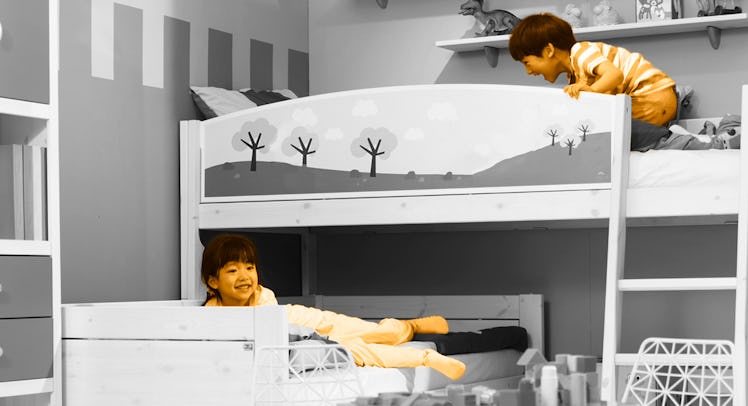How to Teach Siblings to Share a Room
Even very different children can make room-sharing work. Routine and respect are key.

It generally fine for young kids to share a room. But that doesn’t mean a set of bunk beds and a nightlight are all parents need to get siblings to cohabitate harmoniously. Kids with different bedtimes, different nap needs, and different developmental quirks tend to complicate or explode arrangements. But that doesn’t mean that peace cannot be achieved, simply that rules be established in regards to property, privacy, and sleep.
“Routines are king,” says Natalie Moore, a Los Angeles-based family therapist. “Kids need consistency in order to thrive — stick to a daily routine with your children, and you’ll find that there are fewer battles and protestations. If your kiddos understand that their parents mean what they say, there is less wiggle room for last-minute bedtime negotiations or rule-breaking.”
Kids can design their own areas of the room (and there are some pretty rad décor options out there) in order to establish their own space. And the process for choosing the space – who gets the top bunk, what shelves belong to whom – can largely be left up to the kids themselves, within reason.
“If there is a safety or developmental reason to give a child certain liberties, then, of course, make the decision based on age. But if the choice is purely arbitrary, let your kids decide,” suggests Moore. “Allowing your children to problem solve themselves will improve their ability to resolve conflicts on their own down the line, without constant refereeing from parents.”
Once these decisions are made, the process for them may take some time. Younger kids who do not have a strong sense of other people’s property can quickly get on a sibling’s nerves. When that happens, Moore suggests, it can be a learning opportunity for parents to teach their kids how to resolve conflicts and compromise – probably the greatest benefit of sibling room sharing.
“We can’t force kids to respect one another all the time. But we can encourage them to be open and honest about their feelings with one another,” advises Moore. “The more we can foster emotional intelligence in our children, the better they will be able to navigate difficult social situations, not only with their siblings but everyone they come into contact within their lives.”
How to Get Siblings to Share a Bedroom
- Let kids measure their own boundaries – designing, organizing, or decorating their own space can help kids learn to work together and listen to their sibling’s needs.
- Be fair and consistent – parents should make the rules and routines clear and hold kids to those expectations.
- Let them sort it out – parents don’t need to arbitrate every disagreement. Set some ground rules so that problems can be worked through with respect.
- Some situations are non-starters – expectations of modesty, privacy, maturity, responsibility, cleanliness and sleep habits may not be compatible with the gap in age or development is too large.
Still, self-expression is not as simple an issue as decor. Kids with rudimentary language skills are necessarily going to struggle with articulating ideas about fairness. They will get frustrated and angry. They will act out. Sleep compatibility, too, hinges on a certain level of maturity and personal discipline.(Sleep training isn’t the right time to introduce a new roommate; a kid’s sleep pattern and sleep ritual should be already be established.)
If the age gap is significant, parents should anticipate that they will struggle slightly to mediate conversations and that the kids will resent each other. There can be plenty of great rules, but nine-year-olds will still find five-year-olds frustrating. Asking the older kid to just be patient is also not very tenable or fair. Older kids (and adult for that matter) deserve to have their own sleep rituals as well. That’s why it may be best — barring economic restraints — to keep kids of disparate ages apart.
Another thing to consider is that room-sharing simply may not work for reason not related to age. One kid or the other might develop disruptive sleep behaviors like night terrors, nightmares, or sleepwalking. One kid may simply throw the other off by being too active at night. As kids become better sleepers, room-sharing gets easier, but it’s never exactly easy. Sharing is, as every kid comes to learn, tough.
“Make sure that your expectations of your children are developmentally appropriate so that you’re setting your kids up for success,” says Moore.
That means accepting that failure is an option.